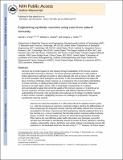Engineering synthetic vaccines using cues from natural immunity
Author(s)
Swartz, Melody A.; Irvine, Darrell J; Szeto, Gregory
DownloadIrvine_Engineering synthetic.pdf (2.378Mb)
PUBLISHER_POLICY
Publisher Policy
Article is made available in accordance with the publisher's policy and may be subject to US copyright law. Please refer to the publisher's site for terms of use.
Terms of use
Metadata
Show full item recordAbstract
Vaccines aim to protect against or treat diseases through manipulation of the immune response, promoting either immunity or tolerance. In the former case, vaccines generate antibodies and T cells poised to protect against future pathogen encounter or attack diseased cells such as tumours; in the latter case, which is far less developed, vaccines block pathogenic autoreactive T cells and autoantibodies that target self tissue. Enormous challenges remain, however, as a consequence of our incomplete understanding of human immunity. A rapidly growing field of research is the design of vaccines based on synthetic materials to target organs, tissues, cells or intracellular compartments; to co-deliver immunomodulatory signals that control the quality of the immune response; or to act directly as immune regulators. There exists great potential for well-defined materials to further our understanding of immunity. Here we describe recent advances in the design of synthetic materials to direct immune responses, highlighting successes and challenges in prophylactic, therapeutic and tolerance-inducing vaccines.
Date issued
2013-10Department
Massachusetts Institute of Technology. Department of Biological Engineering; Massachusetts Institute of Technology. Department of Materials Science and Engineering; Ragon Institute of MGH, MIT and Harvard; Koch Institute for Integrative Cancer Research at MITJournal
Nature Materials
Publisher
Nature Publishing Group
Citation
Irvine, Darrell J., Melody A. Swartz, and Gregory L. Szeto. “Engineering Synthetic Vaccines Using Cues from Natural Immunity.” Nature Materials 12, no. 11 (October 23, 2013): 978–990.
Version: Author's final manuscript
ISSN
1476-1122
1476-4660